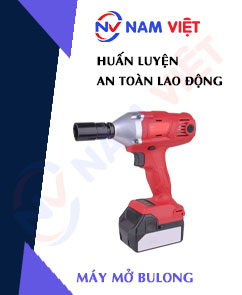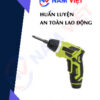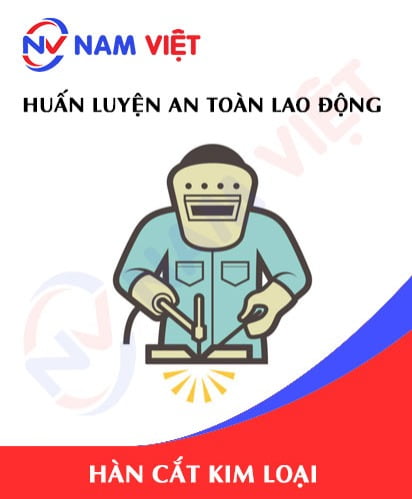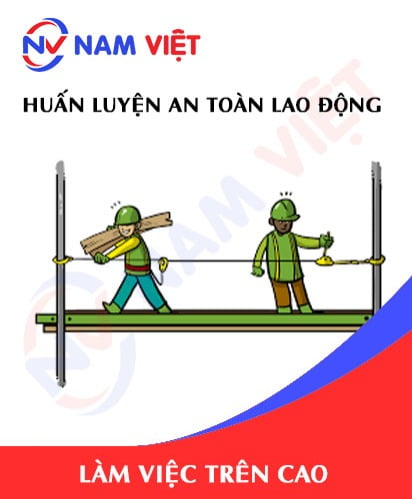Occupational Safety Training for Handheld Impact Wrench Operation
99,000 ₫
Note: The above price is calculated for one person. Prices may vary depending on the number of trainees participating in the course and market fluctuations. For more accurate pricing information, please refer to the price list or contact our consultants directly.
Occupational safety is an important issue when operating a handheld impact wrench and needs to be addressed promptly to ensure the health and safety of workers while also enhancing the reputation of businesses here. The Occupational Safety Training course is one of the effective solutions to raise awareness of accident prevention among workers when operating handheld impact wrenches.
Table of Contents
Toggle1. Overview of the Handheld Bolt Opener
a. What is a handheld bolt opener (bolt openers machine)?
A handheld bolt opener typically has a plug head or opening blade sized and shaped to fit the bolt or screw to be loosened. The user rotates the handle or plug head to perform the loosening operation, helping to remove them from the material or surface into which they are fastened.
Handheld bolt openers come in various sizes and designs to match the specific type of bolt or screw you are working with. This is a tool commonly used in construction, maintenance, repair, and other applications where bolts or screws need to be removed conveniently and quickly.

b. Operating principle of the handheld bolt opener
The operating principle of a handheld bolt opener is similar to that of a standard wrench. The handheld bolt opener is designed to generate a turning force to loosen bolts or screws by applying a rotational force to them. Below is how a handheld bolt opener works:
- Bolt or screw opening head: The handheld bolt opener has a head for opening bolts or screws. This head is designed to match the type and size of the bolt or screw to be removed. The opening head has teeth or blades to grip the bolt or screw securely.
- Rotating wheel or handle: The handheld bolt opener has a rotating wheel or handle that the user holds and turns. When you apply a turning force to the wheel or handle, it converts this force into rotational force applied to the bolt-opening head.
- Rotational force: The rotational force is generated by turning the wheel or handle. The bolt-opening head moves in the direction of rotation and applies torque to the bolt or screw, causing it to loosen from the material or surface in which it is installed.
- Applying force and direction of rotation: The user can control the amount of torque and the direction of rotation by adjusting how they apply force to the wheel or handle. This allows them to control the loosening of the bolt or screw as desired.

c. Industries that use handheld bolt openers
Handheld bolt openers are widely used across many industries and fields. Below are some manufacturing sectors and areas where handheld bolt openers are commonly used:
- Automotive manufacturing: In vehicle production, handheld bolt openers are used to assemble and disassemble bolts and screws on vehicle components, including engines, air-conditioning systems, and other parts.
- Machinery manufacturing: In the manufacturing of machinery and industrial equipment, handheld bolt openers are used to assemble and disassemble bolts and screws on mechanical parts and machine components.
- Construction: Handheld bolt openers are also used in construction and site works to install and remove bolts and screws on structural elements and construction equipment.
- Electronics manufacturing: In the production of electronic devices, handheld bolt openers are used for assembling and disassembling bolts and screws on printed circuit boards, electronic components, and other electronic products.
- Energy sector: Handheld bolt openers are used in the energy industry, for example in the assembly and maintenance of electrical and thermal systems.
- Maintenance and repair: Craftsmen, technicians, and maintenance workers use handheld bolt openers to dismantle, assemble and service equipment and machinery.
- Mechanical trades and DIY: Both individual users and mechanics use handheld bolt openers in DIY projects and personal workshops to remove and install bolts and screws.
2. Overview of the safety training course for operating handheld bolt openers
a. What is occupational safety training?
- Occupational safety training for operating handheld bolt openers consists of lessons that provide awareness on how to prevent workplace accidents for workers. Accordingly, those who work directly with handheld bolt openers are subjects belonging to group 3.
- The safety training course helps workers recognize and prevent hazards, reducing the risk of workplace accidents while working.
REGISTER FOR OCCUPATIONAL SAFETY TRAINING SERVICE
b. Training duration
Initial safety training duration
- Total training time is at least 24 hours, including examination time.
- 8 hours of theory on the system of policies and laws on occupational safety and hygiene
- 8 hours of theory on basic occupational safety and hygiene knowledge
- 4 hours of theory on specialized training content
- 2 hours of practical training on specialized content
- 2 hours for the final theoretical test at the end of the course
The safety training center will schedule the time into multiple sessions depending on arranging study time for workers. However, typically there will be 6 training sessions, the course runs for 3 days, assuming the manufacturing enterprise arranges continuous study time.
Periodic safety training duration
- Before the occupational safety card expires, if a worker wants reissuance they must undergo a periodic occupational safety training course, with the periodic training duration being at least 50% of the initial training duration.
Explanation: the total periodic occupational safety training time is at least 12 hours, including examination time. After completing the periodic course and passing the test, the worker will be reissued or have their occupational safety card extended.
c. Course content
| No. | TRAINING CONTENT | TRAINING DURATION (HOURS) | |||
| Total | Of which | ||||
| Theory | Practice | Test | |||
| I | System of policies and laws on occupational safety and hygiene | 8 | 8 | 0 | 0 |
| 1 | Overview of the system of legal documents on occupational safety and hygiene. | 6 | 6 | ||
| 2 | System of standards and technical regulations on occupational safety and hygiene. | 1 | 1 | ||
| 3 | Specific regulations of state management agencies on occupational safety and hygiene when newly constructing, expanding or renovating works and facilities for production, use, storage and inspection of machines, equipment, materials, and substances that have strict occupational safety and hygiene requirements. | 1 | 1 | ||
| II | Basic knowledge of occupational safety and hygiene | 8 | 8 | 0 | 0 |
| 1 | Basic knowledge of hazardous and harmful factors in the workplace. | 4 | 4 | ||
| 2 | Methods to improve working conditions. | 1 | 1 | ||
| 3 | Safety culture in production and business. | 1 | 1 | ||
| 4 | Rights and obligations of employers and employees; policies and regimes on occupational safety and hygiene for workers; functions and duties of the safety network and safety officers. | 1 | 1 | ||
| 5 | Safety and hygiene regulations, signs and safety instructions, use of safety equipment and personal protective equipment; first aid skills for workplace accidents, prevention of occupational diseases. | 1 | 1 | ||
| III | Specialized training content | 6 | 4 | 2 | 0 |
| Comprehensive knowledge about types of machines, equipment, substances that generate hazardous and harmful factors; analysis, assessment and risk management of occupational safety and hygiene; safe working procedures with machines, equipment, and substances that require strict occupational safety and hygiene controls. | 6 | 4 | 2 | ||
| IV | Final assessment of training content at course completion | 2 | 2 | 0 | 0 |
| Total | 24 | 22 | 2 | ||
See more training content for the 6 groups
d. Occupational safety card
After completing the occupational safety training course and passing the test, workers will be issued an occupational safety card (commonly referred to as a occupational safety certificate for group 3).
The group 3 safety card will display information such as full name, date of birth, the job and specific working environment. It will also include the training duration, an official red stamp and a signature confirming course completion.
According to the card issuance regulations specified in Clause 2 of Article 24 of Decree 44/2016/NĐ-CP, two cases are distinguished:
- If the employer and the employee have an employment contract with each other, then the employer must sign, stamp and endorse the safety card for the employee who completed the group 3 training from the occupational safety training provider and passed the test.
- In the case of freelance or seasonal workers who do not have an employment contract, the training provider must sign, stamp and endorse the safety card for the worker after they complete the training from the occupational safety training unit and pass the test.

3. Hazards When Operating a Handheld Bolt Opener
Operating a handheld bolt opener can cause a number of hazards if safety rules are not followed. Below are some common hazards when using a handheld bolt opener and how to avoid them:
- Injury from accidents: Using a handheld bolt opener without following safety rules can lead to injuries such as collisions, cuts, and wounds from the bolt opener or from bolts and screws.
- Bolts and screws getting stuck: Bolts or screws can become stuck in materials or surfaces, and trying to remove them can cause damage or injury.
- Loss of control: If the handheld bolt opener is not controlled carefully, it can become uncontrollable and cause collision or injury risks.
- Incorrect use: Using the handheld bolt opener incorrectly can cause damage or leave bolts and screws insecurely fastened.
- Unsuitable attachment heads: Using an attachment head that does not match the size or type of bolt or screw can cause damage to the bolt or screw and to the tool.
- Unintended cutting of surrounding materials: When removing bolts or screws, take care not to cut surrounding materials unintentionally. This can damage the tool and harm the product or materials.
- Pressure control: To control pressure and ensure not over-tightening or over-loosening, the operator must adjust the opening force and pressure applied to bolts and screws. This is especially important to avoid damaging bolts, screws, or surrounding materials.
- Eye and ear protection: Use safety glasses and hearing protection when necessary to protect eyes and ears from flashes, dust, and noise.
- Periodic maintenance: Perform regular maintenance on the handheld bolt opener to ensure it operates correctly and safely. Any malfunction should be repaired immediately.

4. Measures to Control Workplace Accidents When Operating a Handheld Bolt Opener
To control workplace accidents when operating a handheld bolt opener, you must follow the safety measures below:
- Training and instruction: Ensure that all users of the handheld bolt opener are trained and instructed on how to use the tool safely and correctly. This includes understanding how to operate the tool, recognizing potential hazards, and knowing how to handle the bolt opener.
- Personal protective equipment: Equip users of the handheld bolt opener with personal protective equipment, including safety glasses, hearing protection, gloves, and protective clothing when necessary. PPE helps protect the eyes, ears, and hands from injury risks.
- Tool inspection: Before use, inspect the handheld bolt opener to ensure it is functioning properly. Make sure the power cord, switch, and accessories are in good working order and not damaged.
- Use quality bolt-opening tools purchased from a reputable store to ensure equipment stability and safety.
- Identify a safe position: Before loosening bolts or screws, determine a safe position to avoid drilling into hidden structures or objects near the tool.
- Use correctly: Use the handheld bolt opener according to the manufacturer’s instructions and adhere to safety rules. Do not modify or use the tool improperly.
- Limit working time: Avoid working continuously for too long with the handheld bolt opener to reduce the risk of fatigue and loosened fasteners.
- Periodic inspection of the handheld bolt opener to detect safety issues early such as wear, tear, or mechanical failures on the equipment, thereby reducing the risk of workplace accidents.
5. Benefits of Occupational Safety Training
An Toàn Nam Việt provides your company the following great benefits after completing occupational safety training courses as required by Decree 44/2016/ND-CP on Occupational Safety and Hygiene for companies, factories, and enterprises.
- Workers can recognize potential hazards of workplace accidents and from there take preventive measures to avoid accidents.
- Your company can establish risk prevention measures in production, operation, and maintenance processes.
- Minimize costs associated with safety incidents.
- Uninterrupted production increases labor productivity and product quality.
- Comply with occupational safety laws and avoid legal risks.
- Create credibility and professionalism in all aspects, thereby elevating your company’s brand.
The training courses from Nam Việt are the solution to prevent and counter external factors that could impact individuals so they can avoid dangers that may lead to injury or, in severe cases, death.
REGISTER FOR OCCUPATIONAL SAFETY TRAINING SERVICE
6. Customer Feedback After Completing the Training Course
An Toàn Nam Việt has many years of experience in accompanying numerous businesses across Vietnam in general and in the southern provinces in particular. That responsibility is invaluable to Nam Việt, which is why Nam Việt’s Occupational Safety Training work is increasingly professional. The motivation for An Toàn Nam Việt’s growth to date comes from positive feedback as well as suggestions from businesses. Below are feedback samples from partners we have served.
Bac Nam E&C Construction Investment Joint Stock Company
“The first time we used An Toàn Nam Việt’s service I was very surprised by the 24/7 enthusiastic support from the consulting team. The class organization was very quick and convenient for our company — thank you very much for Nam Việt’s service!”
Hoa Dat Construction and Trading Joint Stock Company
“Nam Việt’s service helped us a lot in simplifying occupational safety work and completing safety documentation for our operations. The consulting team responded enthusiastically and promptly to our questions. Five stars for Nam Việt.”
See more customer interview sessions after using the service of An Toàn Nam Việt
7. An Toàn Nam Việt’s Capacity in Occupational Safety Training
An Toàn Nam Việt is a reputable and quality occupational safety training center in Vietnam today. Our occupational safety training sessions are conducted continuously at workshops, factories, or construction sites nationwide (across all 63 provinces and cities in Vietnam).
REGISTER FOR OCCUPATIONAL SAFETY TRAINING SERVICE
License for occupational safety training
- An Toàn Nam Việt has been inspected and granted the certificate of eligibility for occupational safety and hygiene training by the Department of Safety under the Ministry of Labour – Invalids and Social Affairs. This further strengthens our capacity to conduct occupational safety training.

Materials and lectures
- Before training materials are included in the occupational safety training courses, they are reviewed and approved to ensure the lectures are always accurate in content and effective when applied.
- The instructors’ teaching methods are standardized according to An Toàn Nam Việt‘s teaching standards, methods researched and consolidated by experts in occupational safety and hygiene training to deliver the highest knowledge retention for trainees.
Facilities
- Controlling classroom conditions that affect the training process will increase teaching efficiency and trainees’ knowledge retention.
- Our training facilities always arrange spacious classrooms that meet standards for area, lighting, and training equipment, etc.
8. A Nationwide Reputable and Quality Training Center
At An Toàn Nam Việt, we always prioritize occupational safety training as a professional calling. For us, imparting knowledge that helps workers protect themselves so they can have a safe livelihood is contributing to nation building.
To ensure effective training, we prepare carefully and meticulously down to the smallest detail — from preparing tools, training equipment, to curricula, materials, audio, and lighting.
Our occupational safety training instructors are experts with many years of experience in the field. They even have studies identifying hazards across industries and how to prevent them.
Instructors’ lectures are drawn from practical experience and conveyed in the most vivid and easy-to-understand way for workers. These factors help trainees feel comfortable during learning and absorb our teachings well. Of course, the delivered knowledge always adheres closely to Decree 44/2016/ND-CP.
From that, trainees learn many preventive measures against hazards and how to protect themselves. They also apply these appropriately in real work.
Our training center is proud to be a reputable, professional occupational safety training service provider with the following advantages:
- Competitive training costs while ensuring training quality.
- Flexible training schedules aligned with companies’ production situations.
- Fast and lawful procedures for issuing occupational safety training certificates.
- Instructors with many years of professional experience.
- Classrooms with controlled conditions that increase teaching efficiency and trainees’ knowledge retention.
- Lectures tailored to occupational safety work at enterprises.
- An Toàn Nam Việt works dedicatedly and professionally to provide customers with accurate and fastest support.

9. Further References for Occupational Safety Training Materials
- Occupational safety materials for operating a handheld bolt opener
- Occupational safety training materials pack
- Occupational safety training test bank
- Multiple-choice test for occupational safety when operating a handheld bolt opener
- Training slides for occupational safety when operating a handheld bolt opener
1 review for Occupational Safety Training for Handheld Impact Wrench Operation
No comments yet















phanminhhang341
Dịch vụ tốt!!!